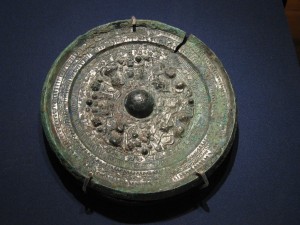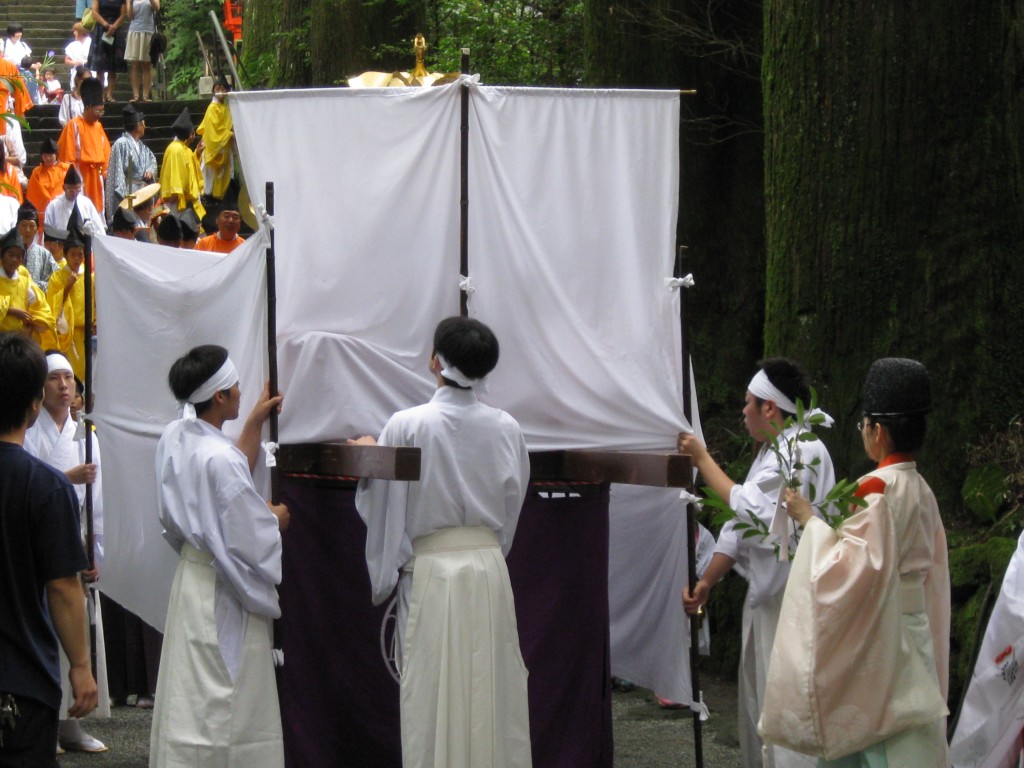At the secret heart of the Shinto shrine is the spirit-body of the kami, locked away in the honden sanctuary and never seen or exposed to public view. It’s a physical object in which the immaterial spirit of the kami is thought to reside. Typically it’s a bronze mirror, though it can also be a sword, magatama jewel, gohei, rock, or simply a wooden tablet with the name of the kami.

The kind of ancient bronze mirror used as shintai. The non-reflecting side, as here, is decorated with patterned shapes and sometimes images.
Why is a mirror the most common spirit-body? In Shinto mythology, Amaterasu the sun goddess gives a mirror to her grandson Ninigi no mikoto when he descends to earth. Imported originally from the continent, mirrors were a shamanistic tool for repelling evil spirits. As rare and expensive items, they were also a sign of spiritual authority. ‘Regard this mirror exactly as if were our august spirit, and reverence it as if reverencing us,’ Amaterasu says to her grandson.
In exceptional cases the shintai is a natural phenomenon outside the shrine visible to all, such as a mountain (known as shintaizan), large rock (iwakura), sacred tree, or waterfall as at Nachi. Omiwa is the most famous case of a sacred mountain as shintai, and it’s possible to make a pilgrimage to the top. Direct worship of natural phenomenon reflects how kami worship originally took place, before the building of shrines following the arrival of Buddhism in the sixth century.
It’s said that the use of shintai arose through the practice of offerings. Mirrors and other items were hung on trees during rituals and festivals (as in the Rock-Cave Myth in Kojiki). These offerings were valuable items, and with the spread of Buddhism came the notion of housing them in a sanctuary (honden). As in religious practice elsewhere, the object became identified with the spirit itself, as if the kami had looked into the mirror and entered it. Only with the spread of permanent shrine buildings in mid-Heian times is the term shintai found (with the honorific it’s usually referred to as goshintai).
At the consecration of new shrines there is a special rite to draw down the kami into the shintai. Thereafter it’s locked away in the honden and only seen by the chief priest at the time of festival outings. In some cases, as at Ise, it is kept wrapped in a cloth covering and never seen even during removal. In other cases it remains undisturbed for generations, and the priest himself may not know what kind of object it is. Mystery of mysteries, indeed!

The shintai is carefully veiled from public view during a festival outing at Hakone Jinja

Do you know the rite to draw the kami into the shintai?
Good day… I don’t know the actual words, but the invocation can be imagined. I’ve been at rituals where kami have been summoned into sakaki branches, so one imagines the procedure must be similar though priests will tell you that only they are qualified to do so. Often an attendant priest utters a wailing sound to indicate the descent of the kami.